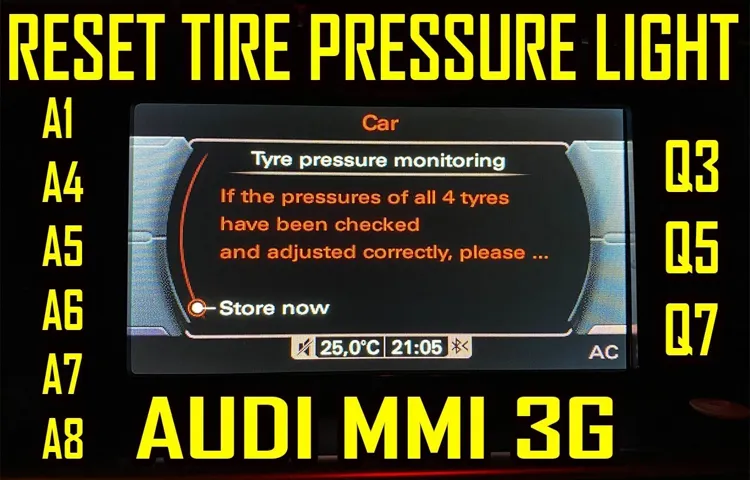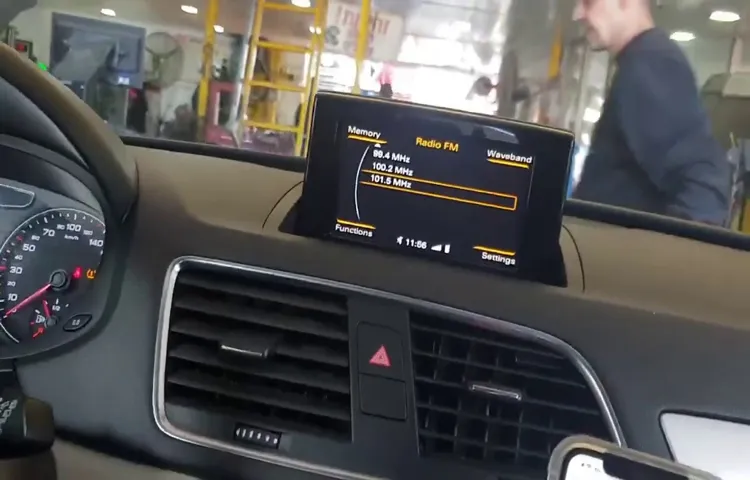Maintaining the correct tire pressure is critical for the safety and longevity of your vehicle. It not only improves fuel efficiency but also prevents tire damage, which can lead to a breakdown on the road. As a proud Audi Q3 owner, you know that you need to check your tire pressure regularly to enjoy a smooth driving experience.
But how do you check the tire pressure on your Audi Q3, and what should you look for? In this blog post, we will guide you through the process step-by-step, so you can ensure your Q3’s tires are in optimum condition.
Table of Contents
Why is Checking Tire Pressure Important?
When it comes to driving your Audi Q3, checking your tire pressure is vital for both your safety and the longevity of your car. Properly inflated tires can improve fuel efficiency, handling, and can even prevent a flat tire. Luckily, checking the tire pressure on your Audi Q3 is a simple process that can be done by anyone.
Start by locating the valve stem on your tire, remove the cap and use a tire pressure gauge to check the pressure. Your recommended tire pressure can be found in your owner’s manual or on the inside of the driver’s side door jamb. If your tire pressure is too high or too low, use a compressor or let air out until the pressure is at the recommended level.
Checking tire pressure should be done at least once a month and before long trips to ensure maximum safety and performance on the road. Remember, a few minutes spent checking your tire pressure can save you a lot of time and money in the long run.
Decreases Risk of Accidents
Keeping your tire pressure at the right level is essential to minimizing the risk of accidents when you’re out on the road. Why is this important? Well, tires that are underinflated can be extremely dangerous. When tires aren’t properly inflated, they have less contact with the road, which can drastically reduce their ability to grip the pavement.
This makes it more difficult to control your vehicle, especially in wet or slippery conditions. In contrast, overinflated tires can also be problematic, as they can lead to a loss of control when turning or braking. By keeping your tires properly inflated, you’re reducing the likelihood of a dangerous blowout or skid.
So, make sure you check your tires regularly and add air as needed – it only takes a few minutes, but it can make a big difference in your safety on the road.

Saves Money on Fuel and Tire Replacement
Checking tire pressure is an important aspect of vehicle maintenance that can save you both money and hassle in the long run. Proper tire pressure not only provides fuel efficiency, but it also protects your tires from excess wear and tear that can lead to costly replacements. Overinflated tires cause uneven tread wear and can lead to blowouts, while underinflated tires increase rolling resistance and reduce fuel efficiency.
Checking tire pressure regularly, at least once a month, can ensure that your tires are properly inflated and prolong their lifespan. So, next time you think about skipping the tire pressure check, remember that it’s a small job that can bring big savings in the future.
Improves Overall Car Performance
When it comes to the overall performance of your car, checking tire pressure regularly is crucial. Maintaining proper tire pressure has a significant impact on fuel efficiency, tire wear, handling, and braking. Low tire pressure can cause tires to wear irregularly, leading to a shorter lifespan, and even worse, it can pose a risk to your safety.
On the other hand, overinflated tires reduce the traction and contact patch with the road, leading to poor handling and braking distance. To ensure you have the right tire pressure, consult your vehicle’s owner’s manual or the tire manufacturer’s specifications. Checking tire pressure takes just a few minutes, but it can save you money in the long run by reducing fuel consumption and increasing the lifespan of your tires.
Remember, keeping your tires inflated to the correct pressure not only benefits your pocketbook but also improves your driving experience.
When to Check Tire Pressure on Audi Q3
Maintaining proper tire pressure is crucial for safety and performance in any vehicle, including the Audi Q The recommended tire pressure for an Audi Q3 varies depending on the model and year, but typically it should be between 32-35 psi. Checking tire pressure should be done regularly, ideally once a month or before embarking on a long trip.
To check the tire pressure on Audi Q3, first, ensure that the tires are cold. Remove the valve cap and use a tire pressure gauge to measure the pressure at the valve stem. If the pressure is too low, add air until it reaches the recommended level.
If it’s too high, release pressure until it’s within the recommended range. Properly inflated tires not only improve safety but also contribute to better fuel efficiency and longer tire life, making it worth the effort to check and maintain regularly. So, don’t forget to check your Audi Q3’s tire pressure the next time you gas up!
Before Long Trips
As an Audi Q3 owner, it’s crucial to know when to check your tire pressure, especially before long trips. Tire pressure affects fuel efficiency, handling, and safe driving. It’s always best to check your tire pressure when the tires are cold, i.
e., when you haven’t driven more than a mile or two. This ensures that your car’s weight hasn’t heated up the tires, which could impact the pressure reading.
To check your tire pressure, locate the recommended psi (pounds per square inch) in your Audi Q3 owner’s manual or on the driver’s side doorjamb. Use a tire pressure gauge to check each tire and ensure that it matches the recommended psi. If the reading is lower, add air until it reaches the recommended psi.
If the reading is higher, release air until it reaches the recommended psi. By checking your tire pressure regularly and especially before long trips, you’ll have better fuel efficiency, better handling, and safer driving on the road.
Monthly Checkup
As an Audi Q3 owner, it’s important to maintain your vehicle for optimal driving experience. An essential component in keeping your Audi Q3 in top shape is checking the tire pressure regularly. It’s recommended to check tire pressure monthly or before long drives.
Maintaining proper tire pressure can improve fuel efficiency, reduce tire wear, and extend the life of your tires. You can find the recommended tire pressure on the tire label, located on the driver’s side door jamb or in the owner’s manual. Make sure the tires are cool before checking the pressure with a tire pressure gauge.
If you find that the tire pressure is low, add air until it reaches the recommended pressure. Remember to also check the spare tire, which is often overlooked but just as important in case of emergencies. By regularly checking the tire pressure on your Audi Q3, you can ensure a safe and comfortable driving experience.
After Drastic Temperature Changes
When the temperature changes drastically, it’s important to keep an eye on your Audi Q3’s tire pressure. Extreme changes in temperature can cause your tires to lose or gain pressure, leading to safety concerns and a less comfortable ride. But when should you check your tire pressure? Ideally, it’s best to check your tire pressure when the tires are cold, meaning you should check it before driving or after the car has been parked for a few hours.
This will give you the most accurate reading and help you avoid over or under inflating your tires. So, whether you’re starting your day with a chilly morning commute or ending it on a hot summer day, be sure to check your tire pressure on your Audi Q3 to ensure a smooth and safe driving experience.
How to Check Tire Pressure on Audi Q3
Checking tire pressure on your Audi Q3 is a critical task that shouldn’t be overlooked. Not only does it ensure better fuel efficiency, but it also enhances the safety and performance of your vehicle. To begin, you must locate the tire pressure gauge on your Audi Q3, which can typically be found inside the driver’s side door or on the glove compartment.
Next, unscrew the valve cap on each tire and attach the gauge firmly onto the valve stem. Ensure that the gauge is correctly calibrated and check the tire pressure reading provided. If the reading is below the recommended PSI range, add air to your tire until it reaches the optimal level.
Overinflated tires can be just as dangerous as underinflated tires, so make sure you don’t overdo it. Repeat the process for each tire and ensure that they all have the same pressure. Checking your Audi Q3’s tire pressure regularly can help prevent uneven tire wear, blowouts, and improve overall driving experience.
Step 1: Find the Recommended Tire Pressure
To maintain a safe and efficient driving experience, it is crucial to check your Audi Q3’s tire pressure regularly. The first step is to find the recommended tire pressure, which you can find in the owner’s manual or on the inside of the driver’s side doorjamb. Once you have this information, you can easily check your tire pressure using a tire pressure gauge.
Simply remove the valve cap, place the gauge onto the valve stem, and read the pressure. If the pressure is below the recommended level, use an air compressor or stop by a gas station to fill your tires to the recommended pressure. It is essential to check your tire pressure at least once a month to ensure optimal tire performance and increase the lifespan of your tires.
By doing so, you can also improve your Q3’s gas mileage and overall safety on the road. So, be sure to make tire pressure checks a regular part of your vehicle maintenance routine.
Step 2: Gather Necessary Equipment
When it comes to checking the tire pressure on your Audi Q3, it’s important to have the necessary equipment on hand. Firstly, you’ll need a tire pressure gauge, which can usually be found at your local car parts store or online. It’s also important to have a tire inflator or air compressor at the ready, in case you need to add air to your tires.
Another essential item is a tire valve stem tool, which is used to remove the valve cap and access the valve stem. When you’ve gathered all of your equipment, it’s time to start the process of checking your tire pressure. By doing so, you’ll help ensure that your Audi Q3 is safe and efficient on the road.
Step 3: Remove the Valve Cap and Attach Pressure Gauge
To check the tire pressure on an Audi Q3, you’ll need to follow a few simple steps. The first thing to do is to find the recommended air pressure level for your vehicle. This can usually be found on a sticker inside the driver’s side door or in the owner’s manual.
Once you know the correct pressure, it’s time to remove the valve cap from the tire and attach a pressure gauge. This device will tell you how much air is in the tire and whether or not it needs to be adjusted. Make sure to repeat this process for all four tires, as they may have different pressure levels.
Checking your tire pressure regularly can help improve fuel efficiency, extend tire life, and improve overall safety on the road. By taking these simple steps, you’ll be doing your part to help keep your Audi Q3 in top condition and ensure a smooth ride every time you hit the road.
Step 4: Read the Tire Pressure and Compare to Recommended
When it comes to checking the tire pressure on your Audi Q3, it’s essential to follow the recommended pressure outlined in the owner’s manual. Begin by removing the valve cap on one tire and using a tire pressure gauge to check the pressure level. Compare the reading to the recommended pressure level in the manual, and repeat the process for each tire.
If the pressure is too high or too low, adjust it accordingly using an air compressor and recheck the pressure. Remember, maintaining the correct tire pressure not only improves overall handling and fuel efficiency but also extends the life of your tires. So, take the time to perform this simple check and keep your Audi running smoothly and safely.
Conclusion
In conclusion, checking the tire pressure on your Audi Q3 is a simple task that can keep your vehicle running smoothly and efficiently. Whether you choose to use a tire gauge or your vehicle’s built-in system, always remember to keep your tires inflated to the proper levels recommended by the manufacturer. With a little bit of effort, you can ensure that your Audi Q3 handles like a dream and remains safe for all your adventures on the road!”
FAQs
What is the recommended tire pressure for an Audi Q3?
The recommended tire pressure for an Audi Q3 is typically 32 PSI for the front tires and 29 PSI for the rear tires.
How often should I check the tire pressure on my Audi Q3?
It is recommended to check the tire pressure on your Audi Q3 at least once a month to ensure optimal driving performance and safety.
Can I use a regular tire pressure gauge to check the tire pressure on my Audi Q3?
Yes, you can use a regular tire pressure gauge to check the tire pressure on your Audi
However, some Audi models may also have a built-in tire pressure monitoring system.
Is it safe to drive with low tire pressure on my Audi Q3?
No, it is not safe to drive with low tire pressure on your Audi
Low tire pressure can lead to reduced fuel efficiency, poor handling, and increased risk of tire blowouts.
How do I know if my Audi Q3’s tire pressure is too high?
If your Audi Q3’s tire pressure is too high, you may notice excessive wear on the center of the tire, reduced traction, and a harsher ride.
What should I do if my Audi Q3’s tire pressure warning light comes on?
If your Audi Q3’s tire pressure warning light comes on, it is important to check the tire pressure and inflate as necessary. If the light continues to stay on, it may indicate a more serious problem with the tire or tire pressure monitoring system.
Can I overinflate the tires on my Audi Q3?
Yes, overinflating the tires on your Audi Q3 can lead to premature tire wear, reduced handling, and increased risk of blowouts. Always follow the recommended tire pressure for your specific make and model.


